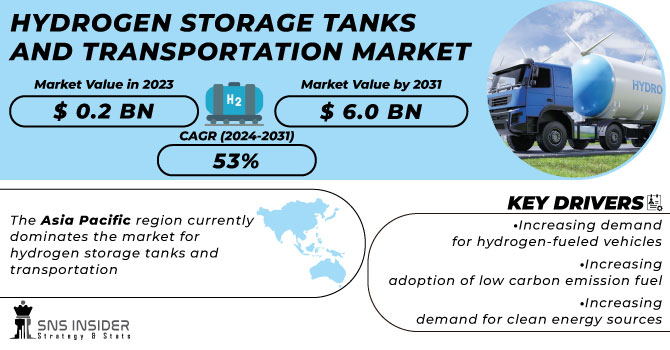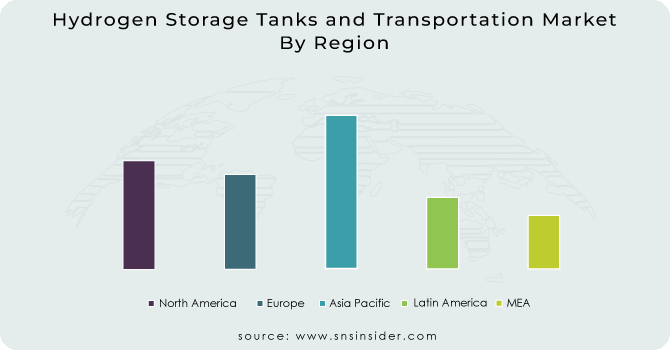Hydrogen Storage Tanks and Transportation Market Report Scope & Overview:
The Hydrogen Storage Tanks and Transportation Market size was valued at USD 0.2 Billion in 2023 and is expected to grow to USD 6.0 Billion by 2031 with an emerging CAGR of 53% over the forecast period of 2024-2031.
Hydrogen storage tanks and transportation are critical components of the hydrogen fuel infrastructure. These tanks are designed to store hydrogen gas at high pressures, typically between 350 and 700 bar, in order to maximize the amount of hydrogen that can be stored in a given volume. The transportation of hydrogen is also a crucial aspect of the hydrogen economy.

To Get More Information on Hydrogen Storage Tanks and Transportation Market - Request Sample Report
Hydrogen can be transported in a variety of ways, including pipelines, trucks, and ships. Each method has its own advantages and disadvantages, and the choice of transportation method depends on a number of factors, including the distance to be traveled, the amount of hydrogen to be transported, and the infrastructure available at the destination.
To ensure the safe and efficient transportation of hydrogen, it is important to carefully design and maintain the storage and transportation systems. This includes selecting appropriate materials for the tanks and pipelines, as well as implementing rigorous safety protocols to prevent leaks and other accidents. In addition to its importance in the hydrogen economy, hydrogen storage, and transportation also have potential applications in other industries, such as energy storage and transportation of other gases. As such, continued research and development in this area is critical to advancing the use of hydrogen as a clean and sustainable energy source.
Market Dynamics
Drivers
-
Increasing demand for hydrogen-fueled vehicles
-
Favorable regulations by the government on hydrogen storage tanks and transportation
-
Increasing adoption of low carbon emission fuel
-
Increasing adoption of hydrogen storage tanks by the transportation industry
-
Increasing demand for clean energy sources
As the world becomes more environmentally conscious, there is a growing need for alternative energy solutions that can reduce carbon emissions and combat climate change. Hydrogen is a promising option, as it can be produced from renewable sources and emits only water vapor when burned. This factor will drive the market for hydrogen storage and transportation.
Restrain
-
High cost associated with composite material-based tank
-
High cost required for producing and storing hydrogen
-
Less efficient as compared to other storage technologies
Opportunities
-
Development of new advanced technologies
Advancements in existing technologies are poised to transform the hydrogen storage and transportation industry, making it more efficient, and cost-effective, and creating new opportunities for hydrogen storage tanks and transportation markets. One such example is the remarkable progress made in fuel cell technology, which has made it possible to use hydrogen as a power source for vehicles. This breakthrough has led to a surge in demand for hydrogen fueling stations and storage tanks, as more and more people recognize the benefits of this clean and sustainable energy source.
Challenges
-
Lack of infrastructure for hydrogen transportation and distribution, which makes it difficult to transport hydrogen to where it is needed.
Impact of COVID-19
The COVID-19 pandemic impacted various industries, including the hydrogen storage tanks and transportation market. The pandemic has caused disruptions in the supply chain, reduced demand, and affected the overall growth of the market. One of the major challenges faced by the hydrogen storage tanks and transportation market is the disruption in the supply chain. The pandemic has caused delays in the delivery of raw materials, components, and finished products. This has resulted in a shortage of hydrogen storage tanks and transportation equipment, which has affected the growth of the market. Another challenge faced by the market is the reduced demand for hydrogen storage tanks and transportation equipment. The pandemic has caused a decline in the demand for hydrogen fuel cell vehicles, which has affected the growth of the market. The reduced demand has also led to a decrease in the production of hydrogen storage tanks and transportation equipment.
Impact of Russia-Ukraine War:
The hydrogen storage tanks and the transportation market is also affected like other industries by the Russian invasion of Ukraine. The market has experienced a decline in growth due to the disruption of supply chains and the increase in transportation costs. Hydrogen storage tanks and transportation are crucial components of the hydrogen economy, which is a rapidly growing industry. The hydrogen economy is based on the use of hydrogen as a clean and renewable energy source. It is used in fuel cells to generate electricity, in transportation as fuel for vehicles, and in industrial processes. The Russia-Ukraine conflict has disrupted the supply of hydrogen storage tanks and transportation equipment, which has led to a shortage of these products in the market. This shortage has resulted in an increase in prices, making it difficult for businesses to afford these products. Furthermore, the transportation costs of hydrogen storage tanks and equipment have increased due to the conflict. The transportation routes have been disrupted, and the cost of transportation has increased due to the risk associated with transporting goods through conflict zones.
Impact of Recession:
The recession has had a significant impact on the hydrogen storage tanks and transportation market. As the economy has slowed down, the demand for hydrogen fuel has decreased, leading to a decrease in the production and sales of hydrogen storage tanks and transportation vehicles. This downturn has affected not only the manufacturers of these products but also the entire supply chain, including suppliers of raw materials and components. The decrease in demand has led to a decrease in prices, which has further impacted the profitability of the industry.
Key Market Segmentation
By Modular Storage
-
Hydrogen Fuel Storage System
-
Hydrogen Distribution System
By Pressure
-
<200 Bar
-
200-500 Bar
-
>500 Bar
By Tank Type
-
Type 1
-
Type 2
-
Type 3
-
Type 4
By Application
-
Vehicles
-
Marine
-
Rail
-
Stationary Storage
-
Trailer for H2 Transportation
Regional Analysis:
The Asia Pacific region currently dominates the market for hydrogen storage tanks and transportation and is projected to experience the highest compound annual growth rate (CAGR) between 2023 and 2030. This growth can be attributed to the region's increasing urbanization and rising per capita income, which has led to a greater demand for hydrogen-based fuel vehicles. As a result, the market for hydrogen storage tanks and transportation is expected to continue to expand. Another factor includes the region's strong focus on renewable energy and sustainable development. One of the key drivers of the Asia Pacific region's success in this market is its robust infrastructure for hydrogen production and distribution. The region has invested heavily in developing hydrogen fueling stations and pipelines, which has helped to create a reliable and efficient supply chain for hydrogen. Furthermore, the region's strong regulatory framework and government support for renewable energy and sustainable development have created a favorable environment for the growth of the hydrogen storage and transportation market.

Do You Need any Customization Research on Hydrogen Storage Tanks and Transportation Market - Enquire Now
REGIONAL COVERAGE:
-
North America
-
USA
-
Canada
-
Mexico
-
-
Europe
-
Germany
-
UK
-
France
-
Italy
-
Spain
-
The Netherlands
-
Rest of Europe
-
-
Asia-Pacific
-
Japan
-
South Korea
-
China
-
India
-
Australia
-
Rest of Asia-Pacific
-
-
The Middle East & Africa
-
Israel
-
UAE
-
South Africa
-
Rest of the Middle East & Africa
-
-
Latin America
-
Brazil
-
Argentina
-
Rest of Latin America
-
Key Players:
The major players are AMS Composite Cylinders, Plastic Omnium, Worthington Industries, Hexagon Purus, NPROXX, Tenaris, Weldship Corporation, Composite Advanced Technologies, LLC., Luxfer Gas Cylinders, Mahytec, UMOE Advanced Composites, Pragma Industries, Marine Service Noord, other key players mentioned in the final report.
Plastic Omnium-Company Financial Analysis

| Report Attributes | Details |
| Market Size in 2023 | US$ 0.2 Bn |
| Market Size by 2031 | US$ 6.0 Bn |
| CAGR | CAGR of 53.0% From 2024 to 2031 |
| Base Year | 2023 |
| Forecast Period | 2024-2031 |
| Historical Data | 2020-2022 |
| Report Scope & Coverage | Market Size, Segments Analysis, Competitive Landscape, Regional Analysis, DROC & SWOT Analysis, Forecast Outlook |
| Key Segments | • By Modular Storage (Hydrogen Fuel Storage System and Hydrogen Distribution System) • By Pressure (<200>500 Bar) • By Tank Type (Type 1, Type 2, Type 3, and Type 4) • By Application (Vehicles, Marine, Rail, Stationary Storage, Trailer for H2 Transportation) |
| Regional Analysis/Coverage | North America (USA, Canada, Mexico), Europe (Germany, UK, France, Italy, Spain, Netherlands, Rest of Europe), Asia-Pacific (Japan, South Korea, China, India, Australia, Rest of Asia-Pacific), The Middle East & Africa (Israel, UAE, South Africa, Rest of Middle East & Africa), Latin America (Brazil, Argentina, Rest of Latin America) |
| Company Profiles | AMS Composite Cylinders, Plastic Omnium, Worthington Industries, Hexagon Purus, NPROXX, Tenaris, Weldship Corporation, Composite Advanced Technologies, LLC., Luxfer Gas Cylinders, Mahytec, UMOE Advanced Composites, Pragma Industries, Marine Service Noord, other |
| Key Drivers | • Increasing demand for hydrogen-fueled vehicles • Favorable regulations by the government on hydrogen storage tanks and transportation • Increasing adoption of low carbon emission fuel |
| Market Opportunities | • Development of new advanced technologies |

